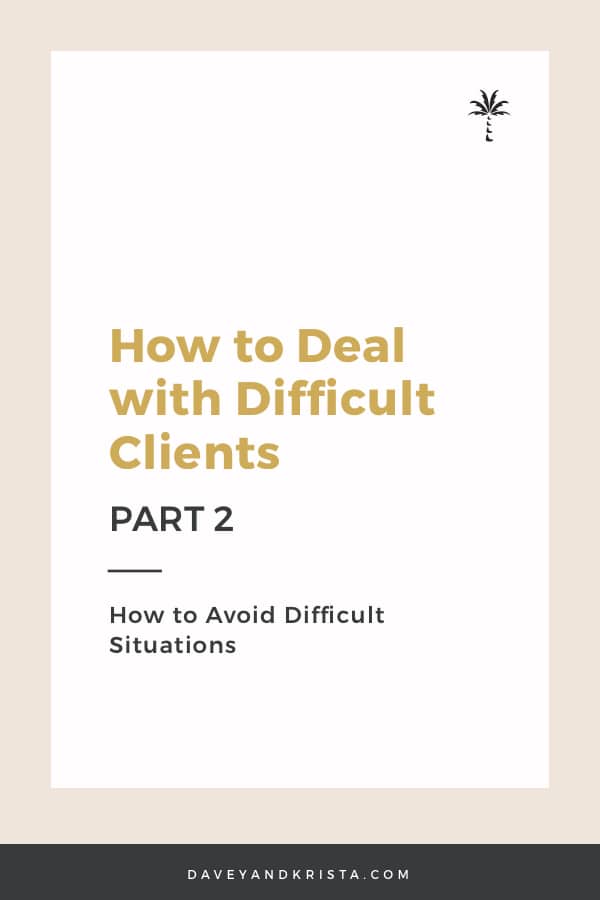A few weeks ago we wrote a post about dealing with difficult clients. If you’re currently dealing with a difficult client, part 1 is where you’ll want to start.
This post is about preventing difficult client situations before they happen.
While there a whole lot of things one can do to prevent such situations, much of learning how to avoid difficult clients comes down to experience. Unfortunately it sometimes takes a few bad experiences to help one identify the warning signs that a client might not be a good fit.
Here’s our best attempt at sharing what we’ve learned from our experiences so that you might have one less difficult client experience.
Ask qualifying questions
After someone submits an inquiry, we respond to that inquiry with information about the services they’re interested in and a list of questions. The questions are meant to gather more specific information about the project or event, and to qualify whether it will be a good fit for us.
We don’t ask a lot of questions—generally between 3 and 5 depending on the service—because we don’t want it to be a chore for people to complete. We preface the questions by saying that we only take a limited amount of clients and want to make sure each one is a good fit (for them and for us!).
There are two levels screening here. The first is in the information we send over. Some people will review it, see the prices, and decide we’re not in their budget or not a good fit. The questions are the second level. We ask specific questions to figure out whether that client might be a good fit. For example, we used to ask photography inquiries, “What pictures are most important to you on your wedding day?” Responses like, “We only want reception photos.” would indicate to us that we probably weren’t the best fit for that couple. One couple even responded that photos weren’t that important to them.
It’s a simple question, but it reveals a lot about a person’s expectations.
And questions don’t have to be asked in an email. They could probably be worked into a consult meeting. Be sure that the questions asked are truly qualifying questions. Asking someone “How badly do you want to work with me on a scale from 1-10?” is not—in my opinion—a good qualifying question.
Spot the Warning Signs of Difficult Clients
Much of this is learned through the experience of working with clients and picking up on what behaviors are indicators that they might be difficult down the road. We try to spot signs through the inquiry process and any consult/discovery meetings. For instance, if someone inquires and says they want a website that looks just like someone else’s website, that’s usually an indicator we’re not a good fit. Or if a prospect is haggling about the contract or price or payment schedule—probably a warning sign.
A quick word about warning signs: We’ll usually go as far as the consult stage with someone even if there are a few warning signs because there’s always a chance those signs are being misread.

We make sure we’re up front and clear about our concerns during those consult calls. Sometimes we find it’s just a matter of educating a prospect.
Say No and Refer Someone Else
One common question we get at this point: How do we say no to a prospective client if it’s not a good fit?
We just tell the prospect that we’re not a good fit, provide an explanation, and ask if they’d like a few referrals. For instance, if someone reaches out and says they’re looking for dark-and-moody photographs, but you’re aesthetic is light-and-airy, you might say something like:
Hi First Name,
Thanks for reaching out about family portraits. Based on what you said in your inquiry, I don’t think I’m the best fit to take portraits for your family since my style is lighter than what you seem to want.
I’d be happy to send over a few names of people whose style might be a better fit. Or if you decide my style [link to work] is what you’re looking for, we can set up a call to chat more.
I can’t remember one instance where someone got upset with us because we told them we weren’t a good fit for their project. And if someone does get upset, it’s just confirmation that they’re not the right fit.
Niche Down
There are all sorts of reasons for niching down. It makes marketing your product or service easier because you can get crystal clear with your messaging. But you’ll be able to more quickly identify areas in the experience that are a struggle for potential clients since you’ll see a similar process play out over and over again. When you work with all sorts of clients, it might be harder to identify issues because different things might be difficult for each kind of client.
Another benefit of “niching down”: Life will be easier when it comes to completing the work.
When you niche down and work with the same kinds of clients, you can create “rinse-and-repeat” systems. Onboarding, for instance, will most likely look the same for each client, so you can create an onboarding template in Dubsado or ClickUp or whatever project management system you use. You can create “canned emails” for emails you regularly send throughout a project. These kinds of systems and standardization can help with client management and expectations throughout the project.
Have a Strong Contract and Review It with Your Clients
Contracts are an investment that returns peace-of-mind.
When you’re first getting started, this might not be something you want to spend money on. But one should, especially in the beginning when one lacks experience and there’s all sorts of things that could happen that aren’t expected. Simply creating a contract with an attorney might help you think through some of the pitfalls or potential areas of confusion in your business.
It will also set expectations between you and your client. Be sure to clearly outline the scope of your work, cost of services/products, payments and payment schedule, and other areas that might become a point of tension during the experience. Be sure to review your contract with your clients or at least ask if they have any questions about it. Sometimes clients will sign your contract before they read it. This might sound like their problem—and to a certain extent it is.
But your life will be easier if you tackle any contract confusion before the project begins. Many of our contracts are from The Contract Shop, an online store that provides affordable, attorney-created contract templates for a variety of business types.
Set Expectations… repeatedly
Expectations are something to be managed. It’s not enough to review them once or hope that someone reads the contract. This is especially true when a gap exists between signing the client and completing the work.
Looking at you, wedding industry folk.
We often have a waiting list for design work, which means a few months could go by before we start a client’s project. And we are reminded time and again of the importance of re-educating our clients about expectations.
Here are a few ways to do this:
- Review the contract with clients before the project starts.
- Create a series of onboarding documents for clients to review that outline the experience.
- Provide next steps at the end of each email so clients know what action to take and what’s coming up in the project.
- Occasionally check in to see how things are going, especially at natural transition points within projects (i.e. moving from branding to web design or between the engagement session and wedding).
A great way to reflect upon and anticipate the areas of your client experience that might become difficult is using this client experience timeline activity. It’s something we revisit at least annually.
Reflect on Why It Happened in the First Place
The hard truth about difficult client experiences is that often both parties contribute—as much as we’d like to believe otherwise. Reflecting on one’s part in a poor experience and figuring out how it can be avoided in the future can be a powerful exercise in improving one’s client experience.
Often times difficult situations arise because of a lack of education on the client’s part. Remember: You do this for a living, and it’s easy to forget how much you know… and how little a client might know about what it is that you do. Sure, this isn’t business’s fault, per se. But providing more education throughout the process can lead to a much better experience for both parties, and so it’s worthwhile for a business to do so.
We’ve recently started doing quick “post-mortem’s” on projects. We keep it simple, and record everything in a Google Doc. This gives us an opportunity to reflect on the highlights—both positive and negative—of a project. It also helps us spot areas that continue to be difficult and places where we need to be better about educating our clients.
It happens
As we mentioned at the beginning of this post, these are things that are often learned through experience. If you end up having a difficult experience with a client, try to remember that sometimes these things happen (and we hope the part one of this two part post helps in that case). Be sure to reflect, adjust, and move on.
But, we hope that some of the things we learned through our experience helps you avoid those situations as much as possible.
Have questions? Post them in the comments below or tag us on social media.








VIEW THE COMMENTS
Add A Comment